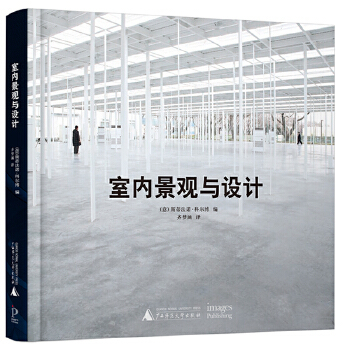
出版时间:2016-06-01
定 价:248.00
作 者:(意)斯蒂法诺·科尔博 编 齐梦涵 译
责 编:肖莉 齐梦涵
图书分类: 室内设计/装潢装修
读者对象: 建筑设计单位、景观设计师、建筑师、建筑与景观设计兴趣爱好者
上架建议: 景观设计
开本: 12
字数: 80 (千字)
页数: 224

现代建筑一般是以内外结构布局的整体渗透为特征的:在这统一而又对立的两极间,区别变得越来越难以辨认,边界越来越模糊不清,任何设计过程,根据对不同和异质的层次的叠加,其结果都将是一个混合性产物。
乍看之下,建筑界对内外部这种新的对立统一的兴趣似乎是最近才出现的,如果仔细研究,人们就会发现,内部和外部的矛盾在建筑领域一直存在,且在每个世纪里都以不同的呈现方式,做出不同的表达。
本书从18世纪讲起,为读者描绘这两者关系的本质,以此揭示那些跨越建筑史、隐匿于世的永恒的形式、原则和概念。
区别、逆转、渗透、瓦解,以上各类手法周期性地表现着内部和外部的对立统一。通过运用不同的说明手段——图纸、照片、绘画——《室内景观与设计》以图集的形式,为读者展示通过内部与外部的相互渗透,日久常新的建筑理论是如何出现的。
《室内景观与设计》一书的挑战在于它对现代建筑理论进行细致的剖析,并提出一个能够激发人们探讨的新话题。
斯蒂法诺•科尔博(Stefano Corbo)是一名意大利建筑师、研究员和教育家。他于2010年获得马德里理工大学建筑学院高级建筑设计专业的MArch II学位,现在是该学校的博士候选人。他为多家学术机构授课:贝鲁特的黎巴嫩美国大学、意大利阿尔盖罗建筑学院、马德里理工大学建筑学院;他也是爱丁堡建筑与景观设计学院、墨尔本迪肯大学、迈阿密大学、麻省理工学院、威斯康星大学的客座讲师。他的第一本书《从形式主义到弱式:彼得•艾森曼的建筑和哲学》(From Formalism to Weak Form: The Architecture and Philosophy of Peter Eisenman)在2014年12月出版。他在2012年离开了曾经工作过的梅卡诺建筑事务所(Mecanoo Architecten),创办了自己的建筑设计事务所SCSTUDIO(www.scstudio.eu),这是一个多学科网络架构,专注于研究当代知识、经济和文化背景之中的建筑设计。
9 致谢
11 导言
12 区别、逆转、渗透、瓦解
20 一个困扰着现代性的幽灵:透明度
30 建筑残骸
41 仿野外结构和数据景观
52 时间、表现、使用
63 云性质
72 建筑学和生理学的边界
83 图集
216 参考书目
218 版权信息
222 索引
本书着重从历史的角度揭示建筑设计不变的形式、原则和概念。
本书的引言和后记,把书中的每张图片还原到了它们所属的领域,使本书提及的理论与实践相结合,为本书创建了精确清晰的脉络。
本书不仅有理论研究,也以画集的形式呈现,使它的娱乐性增强,扩大受众。
本书与近期建筑设计类图书关注的大多数话题有关,并为读者提供了不同的见解。
随着时代的发展,室内与室外的概念相互渗透,其区别变得越来越难以辨认,边界越来越模糊不清,任何设计过程,根据对不同和异质的层次的叠加,其结果都将是一个混合性产物,本属于室外范畴的景观逐步渗透进室内的领域。本书从历史上的建筑讲起,为读者描绘室内室外这二者关系的本质,以此揭示那些跨越建筑史、隐匿于世而又周期性出现并塑造当代典范的永恒的建筑形式、原则和概念。
Time, Performance, Use
THE FIELD-LIKE condition of the architectural typologies emerged in the last decades implies not only the necessity to deal with visible and invisible data, as formerly described in the case of the data centers, but has also generated a cartography of concepts and terms that have been gradually incorporated in the syntax of architecture. To some extent, it’s possible to structure a discourse around artificial landscapes starting from three interpretative clues, whose interpenetration generates multiple articulations: a notion of time intended as duration, performativity, and the transition from the idea of program to the idea of use.
The notion of time, as already seen in some prodromal manifestations of the 1960s (remember Cedric Price’s Fun Palace, see page 34, or Archigram’s Walking City, see page 36), is certainly crucial to understand the anti-hierarchical character of the recent architectures: the distinction operated by the French philosopher Henri Bergson between the concepts of homogeneous time and pure duration, in fact, has been influencing not only the philosophical debate in the second half of the 20th century, but has also had architectural consequences. According to Bergson homogeneous time is the time we measure, is a practical concept, an agreement to celebrate the scientific progress. On the contrary, the real duration is our interior time, something that occurs and evolves constantly. Reason why it can’t be measurable or classifiable, and is always composed of different rhythms.1 If homogeneous time is a concept used by science, duration implies an individual and personal experience. By borrowing such conceptual separation, recently architecture has attempted to work on the definition of perceptive landscapes, where time is a really intimate dimension. For the Modern Movement, narrative was one of the constitutive elements of its essence: Le Corbusier’s architectural promenade, for instance, guided the subject through a predetermined path in order to provoke in them a set of emotional and psychological reactions, contained in the physical boundaries of the designed space, that is, within a closed system, the user reaches the point B from point A after a sequence of controlled spaces and atmospheres. It‘s a linear trajectory that leaves no possibility for unexpected events to emerge. In contrast, contemporary architecture rejects the imposition of pre-configured methods and models, to encourage the possibility of an open system, one that is open to a free and individual experience, and open to the uncontrolled use of the space. So, the rigid scheme imagined by modern architecture is replaced, in most of the recent episodes, by the interaction of visible and invisible flows, with no orientation or hierarchical space organization.
The Memorial to the Murdered Jews of Europe (2005) in Berlin, designed by Peter Eisenman, is a clear example of the new concept of time transferred to physical space. Its conceptual genesis is connected to Henri Bergson’s thought, because in this project it is evident the reference to the distinction between chronological, narrative time, and time as duration. The time of the memorial, its duration, aims to be different from the time of experience and comprehension. The traditional monument is interpreted by its symbolic imaginary, not for what it represents. The duration of the individual experience doesn’t offer any explication or logic: there is no nostalgia, only memory. So, in this kind of interior landscape, constituted by the intersection of real and fictitious grids, a perceptive divergence between topography and architecture is created (see also Plate 47). Furthermore, the result of the total contamination between figure and ground is a notion of form that doesn’t correspond with the one we have always analyzed as a product of Modernity. It is an idea of form that contains the potentialities and the characteristics of a possible change, of a contamination with other questions associated with experience and time as an individual private dimension.
One of the other fundamental topics deriving from the rise of artificial landscapes deals with performance. In fact, as already displayed in some pioneer examples (FOA’s Yokohama Port Terminal), the potentialities offered by information technology and digital culture have allowed to control the growth and the evolution of any formal configuration in response to specific requirements, namely structural, climatic, programmatic. Energy flows, information, and different gradients of density define the space, that is, form no longer follows function. If FOA’s and MVRDV’s work each represented a sort of primordial prototype, a germinal state that contained the premises of a new syntax, one may argue that the real attempts to design interactive systems, that is, those capable of integrating humankind, architecture and environment into a multilevel organism, came from Japan at the beginning of the 1990s. For example, the Sendai Mediatheque, designed by Toyo Ito and inaugurated in 2001, has played for many years the role of programmatic manifesto for a new era. Like a sort of contemporary Maison Dom-Ino, this project announced the challenges that the architectural debate would be dealing with in the future. Toyo Ito himself conceived his project as the contemporary evolution of Le Corbusier’s didactic project in that it is a potentially infinite superpositioning of layers, extendable and changeable at any moment. For that reason the Sendai Mediatheque was configured as a shared network, based on the interaction of distinct programmatic layers. Every layer has a specific height; even every façade has its own color. Any spatial hierarchy is annulled by avoiding fixing precise functions within precise physical spaces. But the manifesto-character of the Sendai Mediatheque is also due to four fundamental features, namely that Ito conceives architecture only by considering its surrounding context; that its overall image should be open, and gradually changing; that architecture should achieve different degrees of complexity, even if determined by clear principles; and that architecture’s limits should be blurry. While for Modernism architecture had to be based on geometry, grids and purity, the new architecture (preannounced by Sendai Mediatheque) is served by a single concept: fluidity. However, the starting point of Ito’s process of design is still something traditional, if compared with the final result, yet by working at the beginning with a simple Cartesian grid, the Japanese architect begins to manipulate it, and introduce different unstable configurations. The traditional columns, which characterized modern architecture, are replaced by organic fluid tubes that represent at once a kind of artificialization of nature and express an organic process of growth inside the building. Their role is not only decorative—they work like structural trees, have differently sized shapes, and contain lifts, ducts for air conditioning, stairways, etc. In the Sendai project, Ito’s general strategy (which comprised redrawing the classical typologies inherent to museums, libraries or any other public facilities, thus questioning their 19th-century idealized image) is aimed at defining a responsive platform where the concept of public facility is continually discussed and re-interpreted by users, through their participation and interaction. Architecture not only manages natural flows (air, water, etc.), but it is also programmed to manage social information flows (see also Plate 42).
In this sense, the Sendai Mediatheque works as a public space in which the traditional boundaries between interior (architecture) and exterior (environment) are totally blurred. In questioning such millenary opposition, Ito looks at the interior/exterior relationship according to a Neo-Metabolist approach, so connected with the Japanese tradition, and focused on a renovated harmony between nature and architecture. But at the same time, Ito also seems to clearly refer to those provocative proposals of radical groups like Archigram or Archizoom, who in the 1960s claimed the conceptual analogy between architecture and clothing. Many years later, in fact, Toyo Ito affirms that architecture and clothing are both extension of our body and that they protect us from the exterior world, and control energy, yet they also need to be sensitive and delicate. For that reason, architecture as epidermis cannot be a thick layer that isolates from the exterior. Rather, it has to function as a sensor that’s capable of detecting external stimuli, and then exchange information. For the first time, Sendai Mediatheque encourages questions about the interior/exterior relationship, thus, the connection between architecture and environment from a different point of view. Fluidity implies interactive models of use and manages the complete superpositioning between physical and virtual bodies, to use Toyo Ito’s words.2 Ito designs an architecture capable of dealing with a real body, which is linked to the world by physical connections, and a virtual body, which is constituted by the flows of energy and information. The physical and virtual bodies don’t contrast each other, that’s why architecture has to include and overlay them in any design process. The dialogue between a real and virtual body produces what Ito calls “bodies transition,” that is, an environment made of fluid spaces, with no obstacles, completely interconnected each other, where any visitor can receive different perceptive stimulus.

|

|

|
| 会员家 | 书天堂 | 天猫旗舰店 |
 |  |
| 微信公众号 | 官方微博 |
版权所有:广西师范大学出版社集团 GUANGXI NORMAL UNIVERSITY PRESS(GROUP) | 纪委举/报投诉邮箱 :cbsjw@bbtpress.com 纪委举报电话:0773-2288699
网络出版服务许可证: (署) | 网出证 (桂) 字第008号 | 备案号:桂ICP备12003475号 | 新出网证(桂)字002号 | 公安机关备案号:45030202000033号